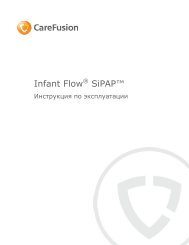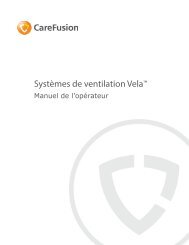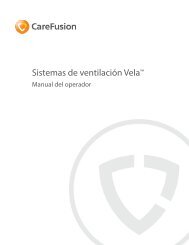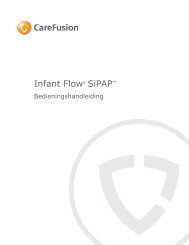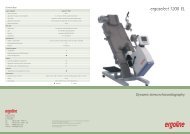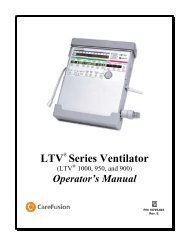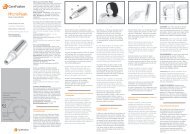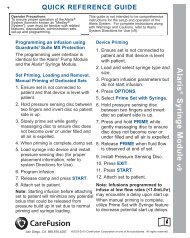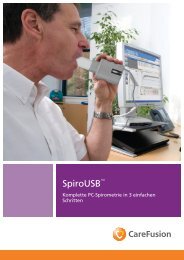3100B HFOV Operator Manual - CareFusion
3100B HFOV Operator Manual - CareFusion
3100B HFOV Operator Manual - CareFusion
You also want an ePaper? Increase the reach of your titles
YUMPU automatically turns print PDFs into web optimized ePapers that Google loves.
4 <strong>3100B</strong> <strong>HFOV</strong><br />
Proper operation of the ventilator must be verified prior to each use. Refer to Chapter 7,<br />
Operational Verification and Startup Procedures. The alarm functions tested in this procedure<br />
verify the capability of the device to detect and indicate conditions that could have a harmful<br />
effect on the patient.<br />
Touch the outer metal cabinet of the instrument before touching any other component to avoid<br />
possible instrument component damage from Electrostatic Discharge.<br />
When the ventilator is connected to a patient, it is imperative that someone be in attendance at all<br />
times in order to react to any alarms and to detect other indications of a problem.<br />
The Inlet Filter Cartridges for the blended gas and the air inputs to the ventilator must be changed<br />
at least every 500 hours of operation as described in Chapter 8, Maintenance and<br />
Troubleshooting. Failure to replace a Filter Cartridge or substitution of an unauthorized<br />
cartridge could result in injury to the patient and/or damage to the equipment. Use only<br />
<strong>CareFusion</strong> Inlet Filter Cartridges.<br />
The filter cartridge body must be screwed back on securely. Cross-threaded or loose installation<br />
will result in leaks and possible dislodging of the cartridge body. If the cartridge body is<br />
dislodged, it will cause the ventilator to cease functioning.<br />
Covers enclosing the Control Package, Column, or any other portion of the ventilator, must not be<br />
removed by the user. To avoid electrical shock hazard, please refer all service requiring cover<br />
removal to a qualified biomedical equipment service technician.<br />
Recheck and readjust alarm levels after any parameter change has been made.<br />
Troubleshooting with the <strong>3100B</strong> should be done “OFF PATIENT” to avoid any potentially<br />
dangerous situations such as abrupt changes in the Pa.<br />
Do not use extraneous ventilator circuit attachments (such as a suction port) without a secondary<br />
external alarm capable of detecting ventilator disconnection. Due to their inline pressure<br />
characteristics, such attachments could possibly keep the Pa alarm from detecting an<br />
accidental ventilator circuit disconnection.<br />
Fractional concentration of inspired oxygen should be verified with an oxygen monitor.<br />
Administration of excessive oxygen to a patient may be harmful. It is imperative that the<br />
prescribed gas mixture is delivered by the blending system.<br />
The Water Trap must be drained at intervals as described in Chapter 8, Maintenance and<br />
Troubleshooting. If the ventilator is operating, leave a small amount of water at the bottom of<br />
the Water Trap container to act as a flow and pressure seal between the ventilator and the<br />
output of the drain.<br />
To help prevent patient injury due to humidifier malfunction, the use of a humidifier with the<br />
following characteristics is strongly recommended:<br />
Thermally protected heater.<br />
Alarms on over-filled water reservoir.<br />
Alarms on under-filled water reservoir.<br />
Alarms when electrically open or shorted temperature probe detected.<br />
Alarms at probe temperatures > 41°C.<br />
Alarms when dislodged temperature probe detected.<br />
Do not place on the Control Package of the ventilator any fluid-containing accessories, accessories<br />
that weigh more than ten pounds, or accessories that extend more than six inches above the<br />
ventilator electronics package or beyond its sides. This could cause damage to the ventilator,<br />
767164–101 Rev. R



